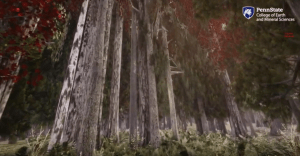
Visualizing Forest Futures allows users to interact with a forest, exploring the impacts of climate change on different tree species. IMAGE: Penn State
Identifying decision-relevant uncertainties for dynamic adaptive forest management under climate change
The decision on how to manage a forest under climate change is subject to deep and dynamic uncertainties. The classic approach to analyze this decision adopts a predefined strategy, tests its robustness to uncertainties, but neglects their dynamic nature (i.e., that decision-makers can learn and adjust the strategy). Accounting for learning through dynamic adaptive strategies (DAS) can drastically improve expected performance and robustness to deep uncertainties. The benefits of considering DAS hinge on identifying critical uncertainties and translating them to detectable signposts to signal when to change course.
Walking through the forests of the future: using data-driven virtual reality to visualize forests under climate change

Altmetric Score
Communicating and understanding climate induced environmental changes can be challenging, especially using traditional representations such as graphs, maps or photos. Immersive visualizations and experiences offer an intuitive, visceral approach to otherwise rather abstract concepts, but creating them scientifically is challenging. In this paper, we linked ecological modeling, procedural modeling, and virtual reality to provide an immersive experience of a future forest.
University center advances energy, environmental knowledge via virtual reality
One of the researchers using the center is Erica Smithwick. She and her team are working on a National Science Foundation-funded project called “Visualizing Forest Futures.”
“We were looking for a medium in which we could engage communities more deeply in conversations about climate change and forest management,” said Smithwick, associate director of the Institutes of Energy and the Environment (IEE). “The immersive environment of virtual reality (VR) allows us to create an environment in which stakeholders can feel immersed in a forest that they can actually visit today.”
Virtual reality forests could help understanding of climate change
“The main problem that needs to be addressed is that climate change is abstract,” said Alexander Klippel, professor of geography, Penn State. “Its meaning only unfolds in 10, 15 or 100 years. It is very hard for people to understand and plan and make decisions.”
The researchers combined information on forest composition with information on forest ecology to create a forest similar to those found in Wisconsin.
“As part of an NSF-funded CNH program grant with Erica Smithwick (E. Willard and Ruby S. Miller Professor of Geography at Penn State) we are working with the Menominee Indian Tribe of Wisconsin,” said Klippel, who also is director of Penn State’s Center for Immersive Experience. “Inspired by the Menominee’s deeper connection to the environment we believe that experiencing the future is essential for all environmental decision making.”
The People’s Forest: How the Menominee are facing climate change
When I dropped by the forestry office of the tribe’s business arm, Menominee Tribal Enterprises (MTE), an interdisciplinary team of scientists from Pennsylvania State University was meeting with the forest manager, Marshall Pecore, and some of his top staff. “A lot of people come here looking for a magic bullet,” Pecore said to the group seated around the conference room table, his arms crossed in his lumberjack flannel. “Menominees believe generally that man is part of the land,” he added. “The rest of society believes man owns the land.”
Climate change impacts on Menominee nation’s forest home focus of NSF funding
A Native American tribal nation in Wisconsin faces cultural and economic challenges as climate change impacts its forest home. A $1.7 million grant from the National Science Foundation will study this relationship and how it could inform decision-making about forest management.
Erica Smithwick, associate professor of geography and associate in the Earth and Environmental Systems Institute, Penn State, is the principal investigator on the five-year project, funded from the NSF Dynamics of Coupled Natural and Human Systems (CNH) program.
